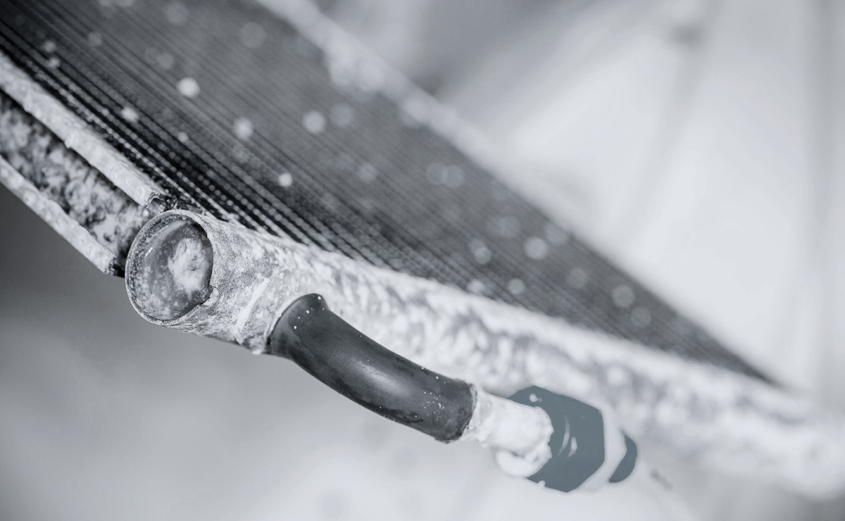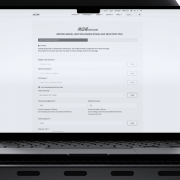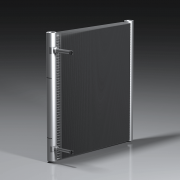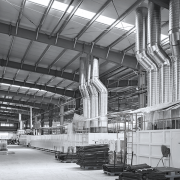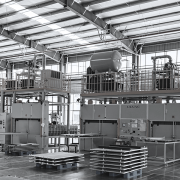Experimental investigation for microchannel heat exchangers corrosion in the coastal environments
Brazed all-aluminum microchannel coils perform superior heat transfer efficiency and capacity at the compact size compared with the conventional tube-fin heat exchangers. Another important factor of growing of microchannel heat exchanger popularity is the high corrosion resistance of aluminum, which is, however, achievable through the careful selection of aluminum alloys, surface treatments, and other protective measures.
Aluminum heat exchangers generally require little or no protection in normal atmospheres. The need is dependent on environmental conditions, particularly in industrial/urban and/or coastal areas and on the alloys used.
Most commonly known corrosion concerns are linked with the use of aluminum in coastal areas and marine environments. These environments may be highly aggressive towards most materials, including aluminum. The aggressivity of sea atmosphere is aggravated by moisture and sea spray consisting of fine droplets of sea waterborne, and the overall effect depends on the direction and strength of the prevailing winds and diminished at distances of kilometers and even dozens of kilometers inland.
Pure aluminum (series 1xxx) has the best corrosion resistance. Performance drops sharply with the introduction of impurities, particularly copper and iron, but increases with the introduction of zinc or magnesium. From the thermodynamical point of view, aluminum is active, but in an oxygen-containing environment, it forms a dense, tightly adhering oxide layer that is inert and prevents corrosion.
The oxide film is generally stable in the pH range of about 4.5 to 8.5, and even beyond this range, but dissolved in most strong acids and alkalines, thus losing the anticorrosive properties that lead to corrosive damage of heat exchangers.
Long-term tests have been carried out in Denmark and France with the use of HVAC units equipped with uncoated and coated microchannel condenser coils made from different alloy compositions and with different surface treatments. Surface seawater pH values were about 8.1 for the western coast of Denmark and about 8.2 for France’s west coast. It was found that the physical-chemical stability of the oxide film is key to aluminum’s resistance to corrosion and highly depends on pH values. In essence, the dissolution rate of the film is high in acid or alkaline media, but are very stable in seawater whose pH is 8.0 to 8.5.
Results of field tests for corrosion showed that aluminum’s resistance to corrosion is the same whatever coastal site has been chosen for tests. Neither salinity level (North Sea, Denmark, with 16-17 g/l chlorides vs. about 35g/l for the Bay of Biscay, France) or annual temperature variation doesn’t affect the corrosion rate. However, the corrosion behavior of aluminum may change due to the presence of pollutants that modify the corrosivity of seawater – specifically in coastal industrial and urban zones.
Contrary to widespread belief, the pH value is not the only criterion for predicting the behavior of aluminum in the marine environment. The nature of the acids or alkalines also plays an essential part. For instance, hydrogen acids are very aggressive towards aluminum, while organic acids only have a moderate action, and nitric acids have no effect on aluminum at all. The same is true for alkalines. Furthermore, most corrosive atmospheric environments, industrial and urban, contain oxides of sulfur that are by-products from the combustion of oil, petrol or coal, and which is converted to sulphuric acid under humid conditions and absorbed in the corrosion process of non-ferrous metals, including aluminum.
It was identified that the stability of oxide film also highly depends on the alloy composition. Some alloying elements like magnesium reinforce the protective properties of the oxide film, while others have limited or no effect. As many systems are bimetallic, often include copper pipework with aluminum to copper connections, galvanic corrosion may occur in the presence of an electrolyte when the contact area between the dissimilar metals is wet, and the more conductive the medium, the stronger the bimetallic corrosion. One way of avoiding bimetallic corrosion is to insulate metals from one another with high ohmic-resistant insulation like neoprene.
Bimetallic corrosion only occurs when metals in contact have a difference in potential of at least 100mV. Dissolution potentials for different aluminum alloys are very close, allowing the use of a combination of alloys in a single heat exchanger core. This is not true for copper and brass, as the difference in potentials between them and aluminum is not less than 350mV, and even more between stainless steel or carbon steel and aluminum.
Stress corrosion cracking may occur on aluminum alloys (especially for high-manganese alloys of 7xxx series) due to a combination of corrosion and static mechanical load; therefore, special attention must be paid to eliminate of vibrations.
Comprehensive protection against corrosion for microchannel heat exchangers can be obtained by the use of special coatings, epoxy electrophoretic coating, or trivalent chromium process (TCP) conversion coating. These coatings passivate aluminum alloys as corrosion inhibitors⁽¹⁾.
Based on Kaltra’s extensive experience and tests of aluminum’s corrosion behavior in marine atmospheres, it can be asserted that the service life of aluminum in aquatic environments is exceptionally long. Still, extreme care must be taken to the following:
- The appropriate corrosion-resistant coating must be used for microchannel heat exchangers operating in coastal atmospheres
- Alloy selection is crucial for corrosion resistance of microchannel heat exchangers
- Special coatings must be used for multi-port tubes of a heat exchanger, e.g., zinc arc spraying
- Reliable insulation of dissimilar metals from each other must be provided for copper or steel connections of a heat exchanger
Sophisticated alloy compositions and the present state of technology of the aluminum industry make it possible to choose an appropriate alloy and coating for it for a specific use and set of operating circumstances. Through the targeted selection of aluminum alloy composition and high-quality coatings, Kaltra offers microchannel heat exchangers that provide a long service life in aggressive environments of coastal installations.
⁽¹⁾ – For detailed information on anti-corrosion properties and coatings for Kaltra microchannel heat exchangers, refer to the Selection Guide for Protective Coatings.

